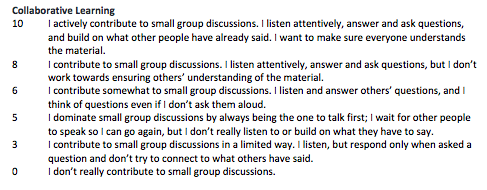Especially for upper-division, discussion-based courses, it’s vital to have input from students on a regular basis in class. In the past, I’ve assessed participation in terms of perceived attendance, recorded attendance, perceived frequency of speaking in class, and quasi-recorded frequency of speaking in class. Obviously, these a) are subjective and prone to bias, b) favor outspoken students, and c) favor quantity over quality. As an introvert who had to force myself to speak up in class once every few weeks, I know that simple measures of participation won’t foster individual growth or make quieter students feel comfortable.
I read a Chronicle article (I think) over the summer about class participation and how hard it is to measure, but how important it can be for student learning. There was a link to a self-assessment rubric from the University of Kansas’s Center for Teaching Excellence (here) and a discussion of how to use it to grade participation. My co-instructor thought this was a fine idea, so with a few modifications, we handed it out at the beginning of the semester, asked students to fill it in, then scanned their responses and returned them. The idea was to have them set goals for themselves and then self-evaluate at the end.

What I like about this rubric is that it considers multiple dimensions to class participation. There’s preparing for class, as in doing the reading. (Bet you most people don’t think of that as participation per se, but it is.) There’s being active in small group discussions and the class as a whole, not only in terms of sharing your own ideas, but encouraging other students to share theirs. I added categories here for those who talk too much and don’t give others room to speak, and for those who engage with the material internally, even if they can’t get themselves to raise their hand. There’s also paying attention in class and not being distracted by texts or other browser tabs–maybe a more passive form of participation, but still vital. And finally, I added a category of participation outside of class, which meant contacting other students for notes, discussing topics after class, or coming to office hours.
Unfortunately, we kind of fell through on implementing this. It wasn’t until about 3/4 of the way through the semester that I realized we hadn’t been checking in with the class on how they were meeting their participation goals, and at that point, it wasn’t clear they would be able to make many adjustments. So we asked for a self-assessment at the end of the semester, which wasn’t done very consistently thanks to our late request, so we had to make do with what we had. But we did still get some good feedback from students on how they prepared for in-class participation by doing the readings to a greater extent than in previous classes, or how they talked about concepts with their friends outside of class even if they weren’t confident enough to speak up in discussion, or how they tried to encourage other, quieter students to share their thoughts.
So in Spring 2020, I’m going to try this again with both my upper-division undergrad/grad class and my graduate seminar, and we’ll see how it goes!
